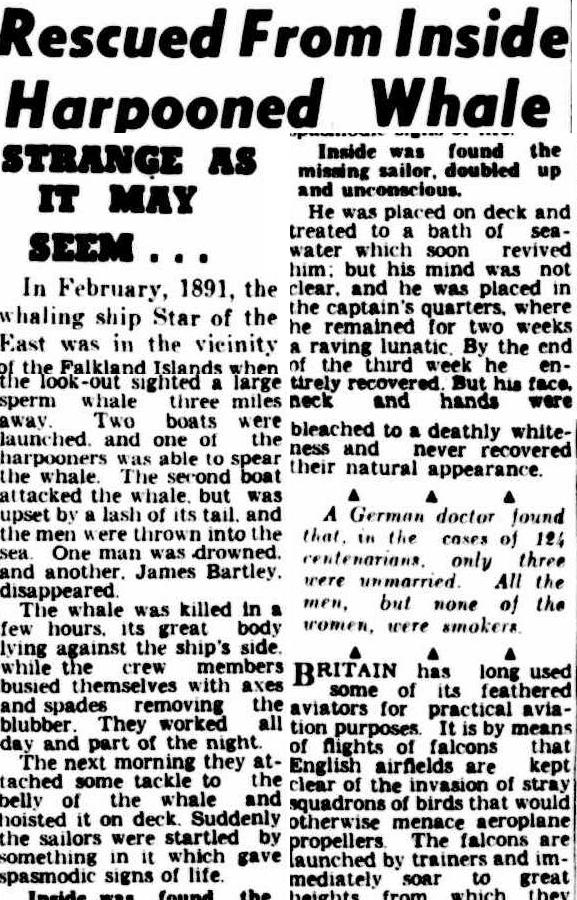Did a 19th-century sailor get swallowed by a sperm whale and survive?

In 1891 two small whaleboats from the British vessel the Star of the East were lowered into the frigid waters of the Falkland Islands, 500km east of Argentina, after sighting a huge sperm whale. Crew member James Bartley, 21, watched as the harpoon met its mark and the creature dived 250m, before the line went slack once more.
Moments later the whale burst from the water, smashing one boat. All but two of its crew were rescued. One of the missing was Bartley. The whale resurfaced and was winched to the ship, where the whalers noticed movements in its stomach, so they cut open its gut.
“Out came a boot on a trousered leg and there was James Bartley…still living after 15 hours in the belly of a whale. Its digestive juices had permanently bleached his skin a deathly white, he lost his hair and was nearly blind. For two weeks he was delirious, and it was a month before he could tell how he’d fallen into the whale’s mouth, felt the huge teeth grate over him as he slid down into its throat, then stomach.

“This modern Jonah lived 18 more years, dying at 39,” continues an account at the Eden Killer Whale Museum on the south coast of NSW, which sources the story to “Records of British Admiralty”. The museum adds a note: “Before diving, sperm whales inhale deeply and rapidly, storing oxygen in muscle fibres, tissues and blood…Could it be that James Bartley survived through the storing up of such oxygen?”
The answer is clearly no. But if the museum swallowed the story, so did the media – for the next 100 years. Bartley was the subject of a cetacean-sized early example of churnalism (the pinching and recycling of one journalist’s story).
The Great Yarmouth Mercury in the UK started this scoop rolling on 22 August 1891 and the Morning Bulletin in Rockhampton, Queensland, snapped up the bait on 11 September. Dozens more papers ran the story virtually word for sourceless word over two years. It wasn’t until 11 May 1907 that Adelaide’s Evening Journal declared “Champion Fish Story, A Hoax Exposed”.
But the tale refused to die and was rerun in many papers over the next two decades. It appeared again in various publications in 1928, 1929, 1931, 1932, 1933, 1934, 1935, 1936, 1938, 1942 (when Melbourne’s The Age gave it a run), 1944, 1947, 1948 and 1953. The yarn continued to be published right up until 1985, when the Sunday Mail even reported how Bartley had settled down as a cobbler in Gloucester, England.
Historians have since concluded that the Star of the East was not a whaler, and there was no James Bartley on its crew manifest, while scientists confirm it is not possible to survive for 15 hours in the stomach of a sperm whale. For nearly 100 years the media largely swallowed this whale of a story without once trying to interview or find a picture of Bartley. It’s a great example of never letting the facts get in the way of a good story.




